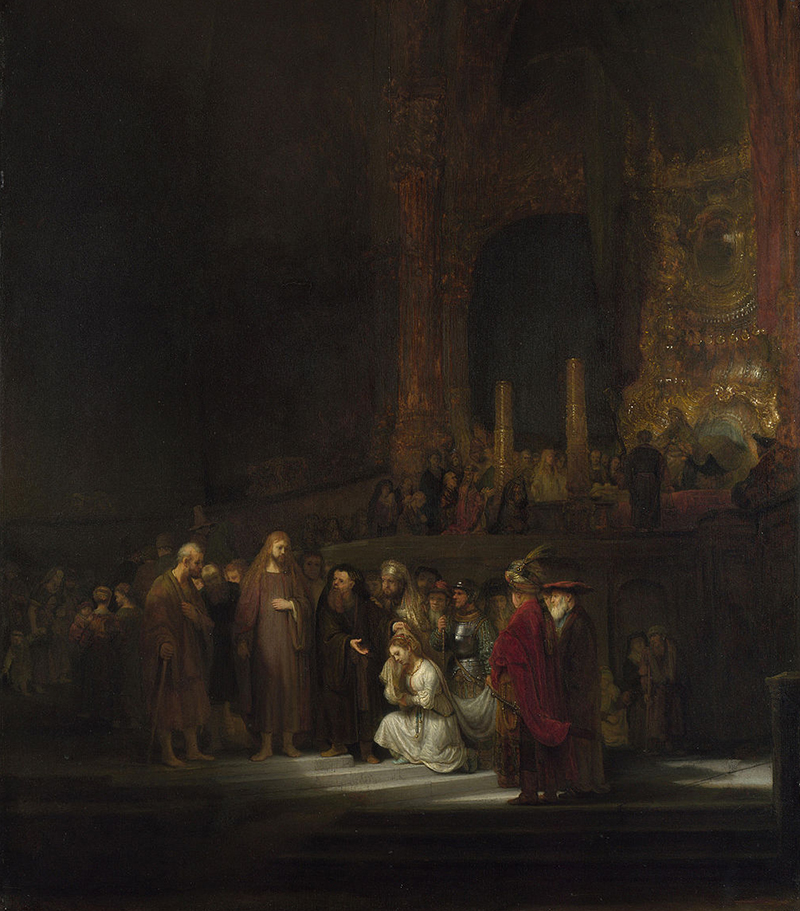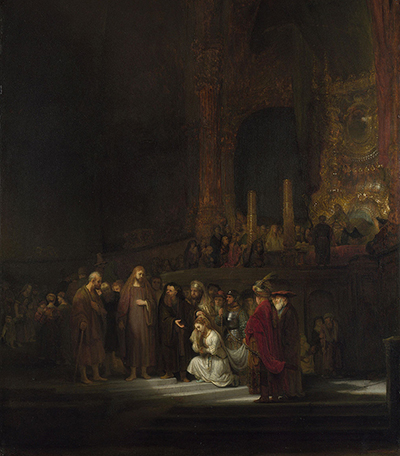In this striking painting, Rembrandt depicts a biblical story from the Gospel of John in which a woman is brought before Jesus as an adulterer.
Jesus asks that any person without sin should cast the first stone, and the woman walks free. In 'Woman Taken in Adultery', Rembrandt brings the scene to life with the beautiful details of the crowd, with the woman herself the focal point in the foreground and Jesus as an imposing, benevolent figure before her who refuses to be tricked by the darker figures around them both.
The painting itself is oil on oak. Rembrandt's art often displays religious themes. What makes them special is the way Rembrandt turns Biblical figures into ordinary people in his scenes.
In this painting the woman is bowed in what appears to be guilt or shame in front of the crowd, with her pale clothes in contrast to the dark robes of the man who brings her for condemnation.
In the original story, the woman is dragged in as an adulteress; the punishment for this sin at the time was to be stoned to death, which was a gruesome and slow way to execute someone. It is no wonder, then, that the woman bows her head in fear of her fate.
Jesus himself appears as the tall, dignified man with a compassionate expression, displaying the meaning below this painting's origin. Jesus is lit in a brighter, warmer light than the people around him, giving him a sense of moral superiority that is part of the meaning behind the biblical story.
Part of the meaning behind the story is that Jesus will not be fooled into betraying his morals or backing down on anything he believes, and because of that he refuses to cast judgment upon the woman until every person that judges her is free of sin themselves; they cannot cast any stone as not one of them is free of sin.
Behind this scene there are shadowy figures who are there as part of the gathering but only exist in the painting to add depth and contrast to the lightness of Jesus and the adulteress. Despite this, every single brush stroke in this painting is masterful, all designed to stand out from the darkness of the scene and to draw the eye to the scene in question.

Rembrandt took care to create realistic images to bring well-known passages in the Bible into a new medium, which then makes it possible to view and understand the meaning behind it in a new light.
The painting was created in 1644, and it displays the empathy for which Rembrandt was known. He takes one of the best displays of this impulse available in Biblical text and creates a painting seeped in it, and creates the complexity of the moment.
Though Rembrandt was initially famous for his portraits during his lifetime, it is scenes like this one that remain a part of the current western canon of art. In 1824 the painting was purchased as part of the National Gallery in London's initial bath of foundation pieces, and remains an important work of art to this day.




